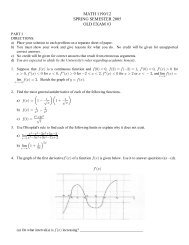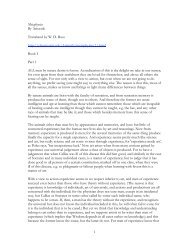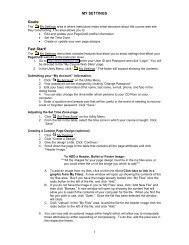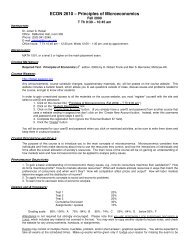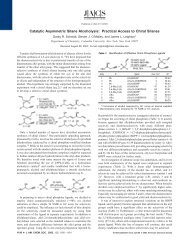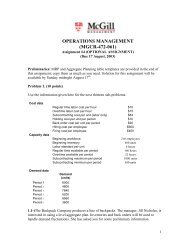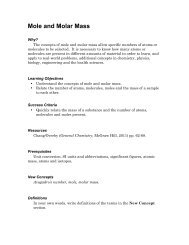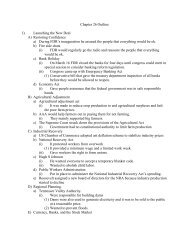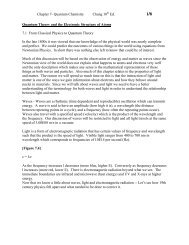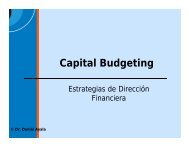OPERATIONS MANAGEMENT (MGCR-472-061) - PageOut
OPERATIONS MANAGEMENT (MGCR-472-061) - PageOut
OPERATIONS MANAGEMENT (MGCR-472-061) - PageOut
You also want an ePaper? Increase the reach of your titles
YUMPU automatically turns print PDFs into web optimized ePapers that Google loves.
Problem 1.<br />
<strong>OPERATIONS</strong> <strong>MANAGEMENT</strong> (<strong>MGCR</strong>-<strong>472</strong>-<strong>061</strong>)<br />
AGGREGATE PLANNING AND MATERIAL REQUIREMENTS PLANNING<br />
PRACTICE QUESTIONS<br />
Leather-All produces a line of handmade leather products. At the present time, the company is producing<br />
only belts, handbags, and attaché cases. The predicted demand for the three products over a six-month<br />
planning horizon is as follows:<br />
DEMAND<br />
MONTH WORK<br />
DAYS<br />
BELTS BAGS CASES<br />
1 22 2,000 1,250 240<br />
2 20 2,800 780 380<br />
3 20 2,500 1,425 210<br />
4 24 3,400 745 75<br />
5 21 3,000 635 126<br />
6 17 2,600 475 145<br />
The belts require an average of 2 hours to produce, the handbags 3 hours, and the attaché cases 6 hours. All<br />
of the workers have the skill to work any product. Leather-All has currently 35 regular time workers who<br />
each have a share in the firm and cannot be fired. There are an additional 25 locals that are available and<br />
can be hired for short periods at higher cost. Regular employees earn a base monthly salary calculated on<br />
the basis of the regular working hours for the month at $8.5 per hour (even if they need to work less). They,<br />
in addition, receive an overtime salary calculated on the basis of the monthly overtime hours they work at<br />
$14 per hour.<br />
Regular time comprises a 7-hour workday and due to union contracts, regular time workers can work at<br />
most 2 hours per day on overtime. The additional temporary workers are hired for $11 per hour and are<br />
kept on the payroll for at least one full month. The cost of hiring and firing of these workers is negligible.<br />
Temporary workers do not work overtime. Leather-All also recognizes that in certain months it can<br />
manufacture more than what is needed, in order to accumulate inventory for future months.<br />
The accountant of the company estimates that 1 worker-hour worth of inventory has a cost of $1 per month.<br />
Likewise, Leather-All recognizes that some demand can be backordered. The estimated cost of<br />
backordering 1 worker-hour worth of demand is $10 per month. The production chief of Leather-All is<br />
totally confused and asks for your help.<br />
a) Using worker hours as the aggregate measure of production, convert the forecasted demands to<br />
demands in terms of aggregate units. Also, convert the amount of capacity (regular time,<br />
overtime, temporary worker) available in terms of aggregate units.<br />
b) Determine the optimal aggregate production plan for Leather-All assuming that demands<br />
cannot be backordered.<br />
1
Problem 2.<br />
Psychics of the World Inc. wants an aggregate plan for their organization. Given the nature of the business,<br />
Psychics has decided that back orders are not acceptable. If a caller cannot be handled immediately, the call<br />
is lost sale.<br />
Psychics has predicted the following number of calls; May-8000 calls, June-5000 calls, July-6000 calls,<br />
August-7000 calls, September-6000 calls, October-8000 calls, November-10,000 calls, December-12,000<br />
calls.<br />
Psychics of the World pays each of their 48 employees $4,000 per month. Each psychic works for 160<br />
regular-time hours per month or 40 regular-time hours per week. The regular-time labor cost of a call is $20,<br />
the overtime labor cost per call is $30. Each psychic is expected to serve 200 callers per month. The<br />
management has limited overtime to 50 calls per month per psychic. It costs $3,000 to hire a new psychic<br />
and $2,000 to fire a psychic.<br />
a) Develop a level aggregate without inventory, without back orders, and without overtime.<br />
b) Using the same problem data, develop an aggregate plan using a level workforce supplemented by<br />
overtime. Minimize the wasted capacity. No back orders are permitted.<br />
Problem 3.<br />
The Bloomington Bike Company produces two models: the Basic and the Supra. Herb Hoosier, the owner,<br />
plans to assemble 15 Basics and 10 Supras each week during periods 4 to 8. Product structure trees for each<br />
bike are shown below:<br />
B<br />
S<br />
X M W K(2) F<br />
F<br />
W(2)<br />
Q<br />
2
Develop a materials requirement plan for component parts K and W over the next eight weeks.<br />
Data on all lead times, current inventory and ordering rules are given below: Scheduled receipts are:<br />
Period 1: 20 B’s, 18 W’s; Period 2: 20 S’s, 15 F’s.<br />
ITEM LEADTIME (WKS) ON HAND LOT-SIZING RULE<br />
B 2 5 Lot-for-lot<br />
S 2 2 Lot-for-lot<br />
X 1 5 Q = 25<br />
W 2 2 Multiples of 12<br />
F 1 10 Q = 30<br />
K 1 3 Lot-for-lot<br />
Q 1 15 Q = 30<br />
M 1 0 Lot-for-lot<br />
Problem 4.<br />
Assume that you are the manager of Assembly Inc. You have just received an order for 40 units of an<br />
industrial robot which is to be delivered at the start of week 7 of your schedule. Using the following<br />
information, determine how many units of subassembly G to order and the timing of those orders given that<br />
subassembly G must be ordered in multiples of 80 units and all other components are ordered lot-for-lot.<br />
Assume that the components are used only for this particular robot.<br />
ITEM LEADTIME (WKS) ON HAND COMPONENTS<br />
Robot 2 10 B, G, C(3)<br />
B 1 5 E, F<br />
C 1 20 G(2), H<br />
E 2 4 --<br />
F 3 8 --<br />
G 2 15 --<br />
H 1 10 --<br />
3
Problem 5.<br />
A manager has prepared a forecast of expected aggregate demand for the next six months. Develop an<br />
aggregate plan to meet this demand given this additional information:<br />
A level regular time production rate of 100 units per month will be used. Backorders are allowed and they<br />
are charged at a rate of $8 per unit per month. Inventory holding costs are $1 per unit per month.<br />
Determine the cost of this plan if regular time cost is $20 per unit and beginning inventory is zero.<br />
Month 1 2 3 4 5 6<br />
Forecast 80 100 120 110 100 90<br />
Problem 6.<br />
A producer of lawn mowers and leaf blowers, must develop an aggregate plan given the forecast for engine<br />
demand shown in the table below. The department has a normal capacity of 130 engines per month.<br />
Normal output has a cost of $60 per engine. The beginning inventory is zero engines. Overtime has a cost<br />
of $90 per engine.<br />
Develop a chase plan that matches the forecast using overtime and slack time, and computer the total cost<br />
of your plan.<br />
Month 1 2 3 4 5 6 7 8 Total<br />
Forecast 120 135 140 120 125 125 140 135 1,040<br />
4
Problem 1.<br />
SOLUTIONS<br />
(a) Month Belts Hours Bags Hours Cases Hours Total<br />
1 2,000 4,000 1,250 3,750 240 1,440 9,190<br />
2 2,800 5,600 780 2,340 380 2,280 10,220<br />
3 2,500 5,000 1,425 4,275 210 1,260 10,535<br />
4 3,400 6,800 745 2,235 75 450 9,485<br />
5 3,000 6,000 635 1,905 126 756 8,661<br />
6 2,600 5,200 475 1,425 145 870 7,495<br />
Month Work Days Reg.Cap. OT Cap. Temp. Cap.<br />
1 22 5,390 1,540 3,850<br />
2 20 4,900 1,400 3,500<br />
3 20 4,900 1,400 3,500<br />
4 24 5,880 1,680 4,200<br />
5 21 5,145 1,470 3,675<br />
6 17 4,165 1,190 2,975<br />
Total 124 30,380 8,680 21,700<br />
(b) No backorders 0 1 2 3 4 5 6 COST<br />
Demand 9,190 10,220 10,535 9,485 8,661 7,495<br />
Production<br />
Regular Time@$8.5 5,390 4,900 4,900 5,880 5,145 4,165 $258,230<br />
Overtime@$14 1,105 1,400 1,400 0 0 0 $54,670<br />
Temporary@$11 3,850 3,500 3,500 3,801 3,675 2,975 $234,311<br />
Inventory End 0 1,155 735 0 196 355 0<br />
Inventory Aver.@$1 577.5 945.0 367.5 98.0 275.5 177.5 $2,441<br />
Total $549,652 TOTAL<br />
Problem 2.<br />
a) Here we are using a level plan. Since inventory and back orders are not permitted, find the period with<br />
the highest demand- December has demand of 12,000 calls which is the aggregate production rate.<br />
12,000 calls divided by 200 calls per psychic per month gives us 60 psychics. So we hire 60-48=12<br />
psychics.<br />
a)<br />
Period May June July August September October November December<br />
Service Calls 8,000 5,000 6,000 7,000 6,000 8,000 10,000 12,000<br />
Regular Time Capacity (calls) 12,000 12,000 12,000 12,000 12,000 12,000 12,000 12,000<br />
Wasted Capacity (calls) 4,000 7,000 6,000 5,000 6,000 4,000 2,000 -<br />
This plan appears to waste substantial capacity – 34,000 more calls could have been handled. Total calls<br />
demanded were 62,000 whereas we had 96,000.<br />
Total Cost Calculation<br />
Regular-time Labor Cost<br />
60 Psychics @ $4,000 for 8 periods $ 1,920,000<br />
Hiring Costs<br />
12 Psychics @ 3,000 $ 36,000<br />
Total Costs $ 1,956,000<br />
5
) Here we use a level workforce. Aggregate production rate is 9,000 calls. We don’t need to hire or fire<br />
since overtime will match the volume of calls – each psychic can provide up to 250 calls per period.<br />
Period May June July August September October November December<br />
Service Calls 8,000 5,000 6,000 7,000 6,000 8,000 10,000 12,000<br />
Regular Time Capacity (calls) 9,600 9,600 9,600 9,600 9,600 9,600 9,600 9,600<br />
Wasted Capacity (calls) 1,600 4,600 3,600 2,600 3,600 1,600<br />
Overtime Capacity needed (calls) 400 2,400<br />
Total Cost Calculation<br />
Regular-time Labor Cost<br />
48 Psychics @ $4,000 for 8 periods $ 1,536,000<br />
Overtime Cost<br />
2800 calls @ $30 $ 84,000<br />
Total Costs $ 1,620,000<br />
This plan reduces the wasted regular-time capacity by 16,400 calls. Total cost is $300,000 less than the<br />
previous plan. Overtime is needed only in 2 periods so it should not create morale problems. This plan is an<br />
improvement but better plans are possible.<br />
Problem 3.<br />
Item: B<br />
Lot Size Rule: L4L<br />
Lead Time: 2 weeks<br />
1 2 3 4 5 6 7 8<br />
Gross Requirements 0 0 0 15 15 15 15 15<br />
Scheduled Receipts 20<br />
Projected Available (5) 25 25 25 25 0 0 0 0<br />
Planned Orders 5 15 15 15<br />
Item: S<br />
Lot Size Rule: L4L<br />
Lead Time: 2 weeks<br />
1 2 3 4 5 6 7 8<br />
Gross Requirements 0 0 0 10 10 10 10 10<br />
Scheduled Receipts 20<br />
Projected Available (2) 2 22 22 22 12 0 0 0<br />
Planned Orders 8 10 10<br />
Item: K<br />
Lot Size Rule: L4L<br />
Lead Time: 1 week<br />
1 2 3 4 5 6 7 8<br />
Gross Requirements 0 0 0 16 20 20 0 0<br />
Scheduled Receipts<br />
Projected Available (3) 3 3 3 0 0 0 0 0<br />
Planned Orders 13 20 20<br />
6
For instance: Period 3 gross requirement is 31=2*(13 of K)+(5 of B)<br />
Item: W<br />
Lot Size Rule: FOQ=12 units<br />
Lead Time: 2 weeks<br />
1 2 3 4 5 6 7 8<br />
Gross Requirements 0 0 31 55 55 15 0 0<br />
Scheduled Receipts 18<br />
Projected Available (2) 20 20 1 6 11 8 8 8<br />
Planned Orders 12 60 60 12<br />
Planned orders are multiples of 12, fixed order quantity size.<br />
Problem 4.<br />
Item: Robot<br />
Lot Size Rule: L4L<br />
Lead Time: 2 weeks<br />
1 2 3 4 5 6 7 8<br />
Gross Requirements 0 0 0 0 0 0 40 0<br />
Scheduled Receipts<br />
Projected Available (10) 10 10 10 10 10 10 0 0<br />
Planned Orders 30<br />
Item: C<br />
Lot Size Rule: L4L<br />
Lead Time: 1 week<br />
1 2 3 4 5 6 7 8<br />
Gross Requirements 0 0 0 0 90 0 0 0<br />
Scheduled Receipts<br />
Projected Available (20) 20 20 20 20 0 0 0 0<br />
Planned Orders 70<br />
Item: G<br />
Lot Size Rule: FOQ=80 units<br />
Lead Time: 2 weeks<br />
1 2 3 4 5 6 7 8<br />
Gross Requirements 0 0 0 140 30 0 0 0<br />
Scheduled Receipts<br />
Projected Available (15) 15 15 15 35 5 5 5 5<br />
Planned Orders 160<br />
For item G, gross requirements are calculated from Robot and item C as;<br />
Period 4 Gross Requirement=2*(70 from C)<br />
Period 5 Gross Requirement=1*(30 from Robot)<br />
7
ROBOT<br />
B G C(3)<br />
E F G(2)<br />
H<br />
Problem 5.<br />
Month 1 2 3 4 5 6 Costs<br />
Forecast 80 100 120 110 100 90<br />
Level Production 100 100 100 100 100 100 $12,000<br />
Beginning Inv. 0 20 20 0 0 0<br />
Ending Inv. 20 20 0 0 0 0<br />
Avg. Inventory 10 20 10 0 0 0 $ 40<br />
Backorder 0 0 0 10 10 0 $ 160<br />
Total $12,200<br />
Problem 6.<br />
Period 1 2 3 4 5 6 7 8 Costs<br />
Forecast 120 135 140 120 125 125 140 135<br />
Output<br />
Regular 120 130 130 120 125 125 130 130 $60,600<br />
Overtime 5 10 10 5 $2,700<br />
Subcontract<br />
Beginning Inv.<br />
Ending Inv.<br />
Avg. Inventory<br />
Backorder<br />
_________________________________________________________________________________________<br />
Total $63,300<br />
8




